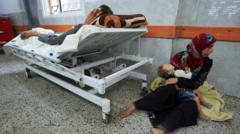In the latest reports from Gaza, hospitals indicate a sharp increase in fatalities as Palestinians attempt to access life-saving aid. The Al-Shifa hospital revealed it received 20 deceased individuals and numerous injured citizens from the Netzarim corridor area, which has been designated as a military zone by Israeli forces.
During the previous night, two hospitals reported the deaths of 25 individuals who were near a convoy delivering flour and a food distribution center managed by the Gaza Humanitarian Foundation (GHF), which has links to U.S. and Israeli support. Accounts from the Hamas-run Civil Defence agency claimed that Israeli troops opened fire indiscriminately, leading to chaos where many were either shot or crushed by trucks amidst the fray. The Israeli military, however, claims their forces issued warning shots to disperse individuals approaching their positions.
In addition to the fatalities in the Netzarim area, another six people were reportedly killed due to Israeli gunfire near a GHF distribution site in Rafah. The GHF has distributed over 43,000 food parcels in its centers around Rafah and central Gaza without incident, but reports of violence persist as the organization attempts to deliver aid since launching its operations on May 26.
The ongoing violence and governmental restrictions worsen Gaza's already critical humanitarian crisis. The Hamas-led health ministry claims that 223 Palestinians have been killed and over 1,800 injured as they sought to reach designated aid areas in the recent weeks. A shift in the aid distribution model, which aims to bypass traditional UN channels as the principal aid provider, has sparked controversy; the UN and other aid groups argue that this new system conflicts with humanitarian principles of impartiality and independence.
The backdrop of these tragedies is the ongoing Israeli military campaign launched in response to a Hamas-led attack on southern Israel on October 7, 2023, which claimed around 1,200 lives and resulted in 251 hostages. The health ministry in Gaza now reports over 55,000 fatalities since the onset of these hostilities, raising urgent concerns about the dire humanitarian situation and the necessity for immediate, unimpeded aid access to the region's 2.1 million residents.
During the previous night, two hospitals reported the deaths of 25 individuals who were near a convoy delivering flour and a food distribution center managed by the Gaza Humanitarian Foundation (GHF), which has links to U.S. and Israeli support. Accounts from the Hamas-run Civil Defence agency claimed that Israeli troops opened fire indiscriminately, leading to chaos where many were either shot or crushed by trucks amidst the fray. The Israeli military, however, claims their forces issued warning shots to disperse individuals approaching their positions.
In addition to the fatalities in the Netzarim area, another six people were reportedly killed due to Israeli gunfire near a GHF distribution site in Rafah. The GHF has distributed over 43,000 food parcels in its centers around Rafah and central Gaza without incident, but reports of violence persist as the organization attempts to deliver aid since launching its operations on May 26.
The ongoing violence and governmental restrictions worsen Gaza's already critical humanitarian crisis. The Hamas-led health ministry claims that 223 Palestinians have been killed and over 1,800 injured as they sought to reach designated aid areas in the recent weeks. A shift in the aid distribution model, which aims to bypass traditional UN channels as the principal aid provider, has sparked controversy; the UN and other aid groups argue that this new system conflicts with humanitarian principles of impartiality and independence.
The backdrop of these tragedies is the ongoing Israeli military campaign launched in response to a Hamas-led attack on southern Israel on October 7, 2023, which claimed around 1,200 lives and resulted in 251 hostages. The health ministry in Gaza now reports over 55,000 fatalities since the onset of these hostilities, raising urgent concerns about the dire humanitarian situation and the necessity for immediate, unimpeded aid access to the region's 2.1 million residents.




















